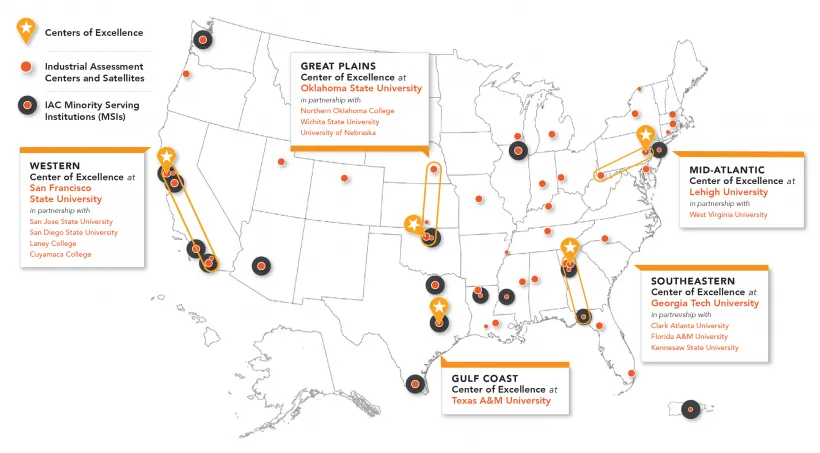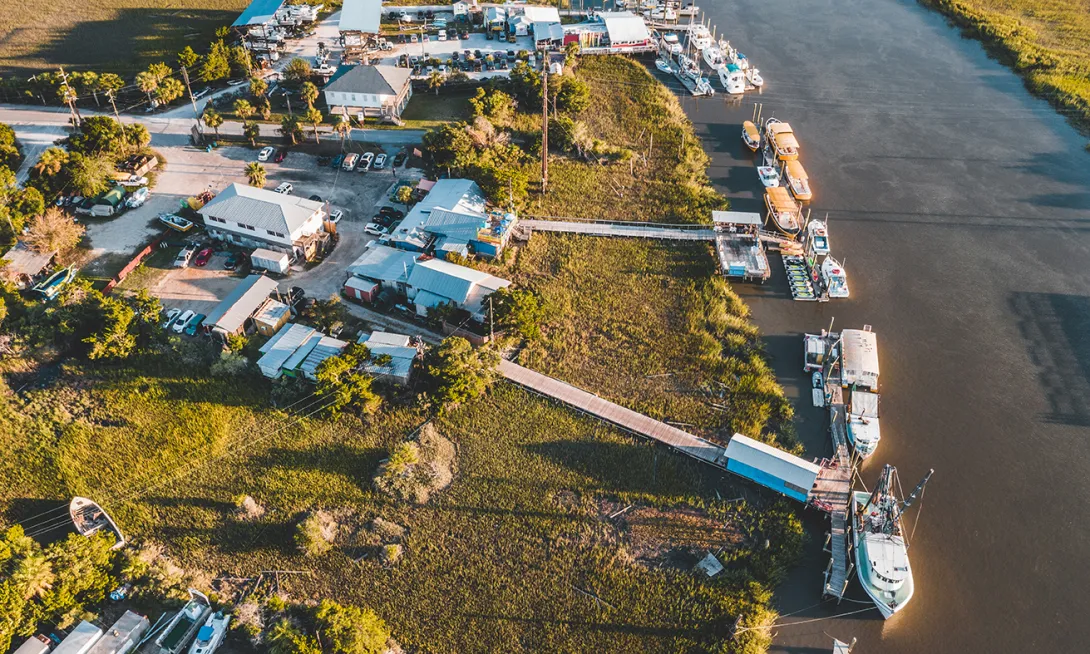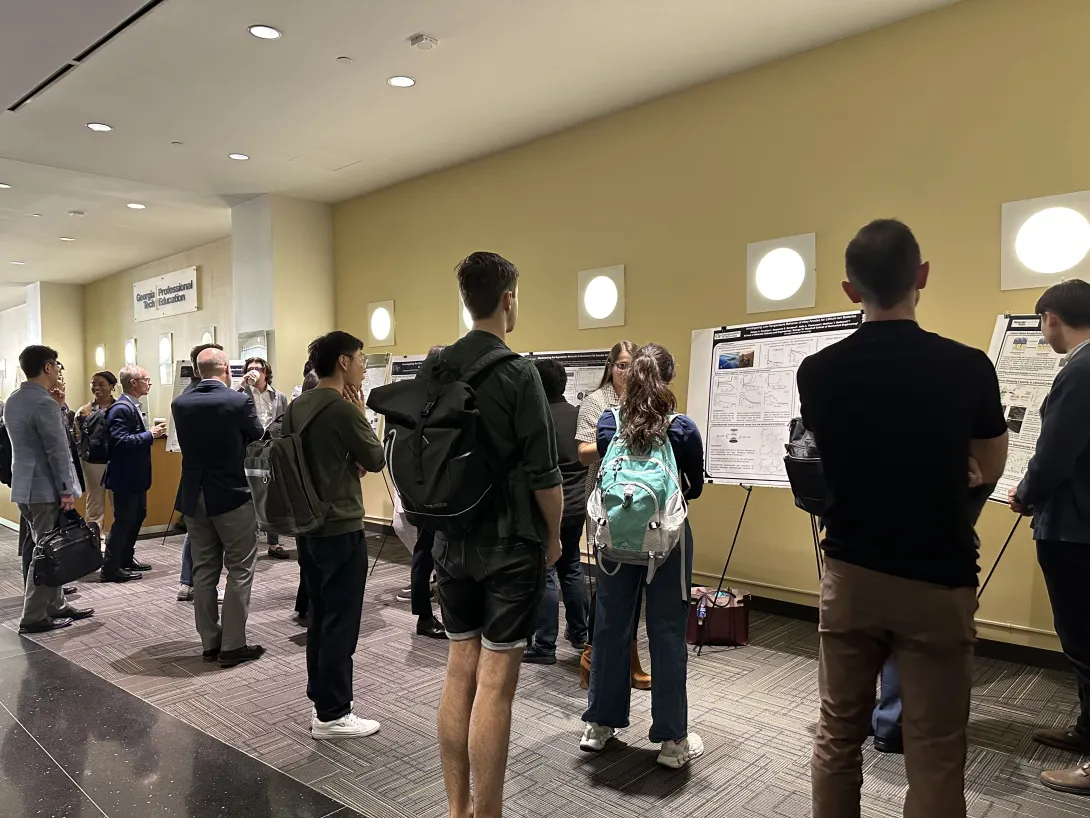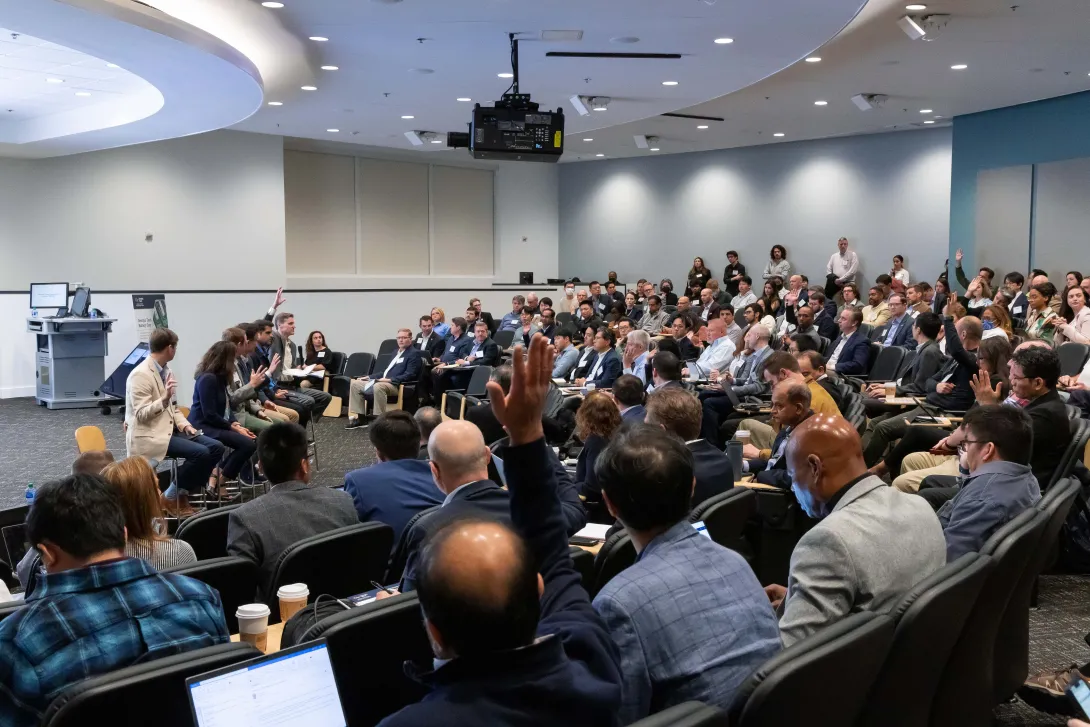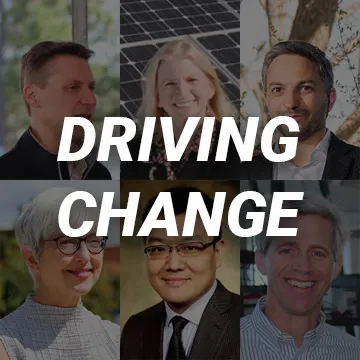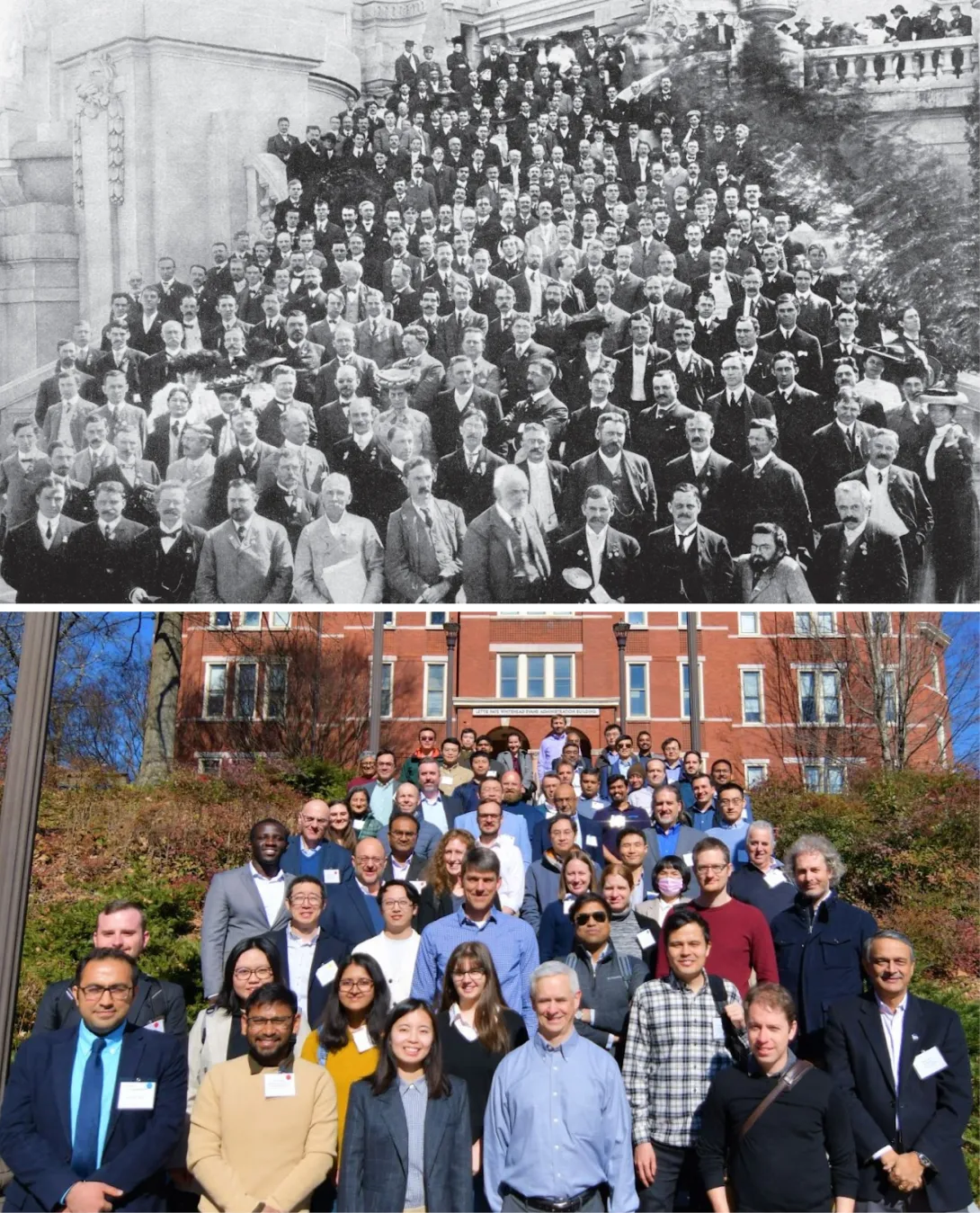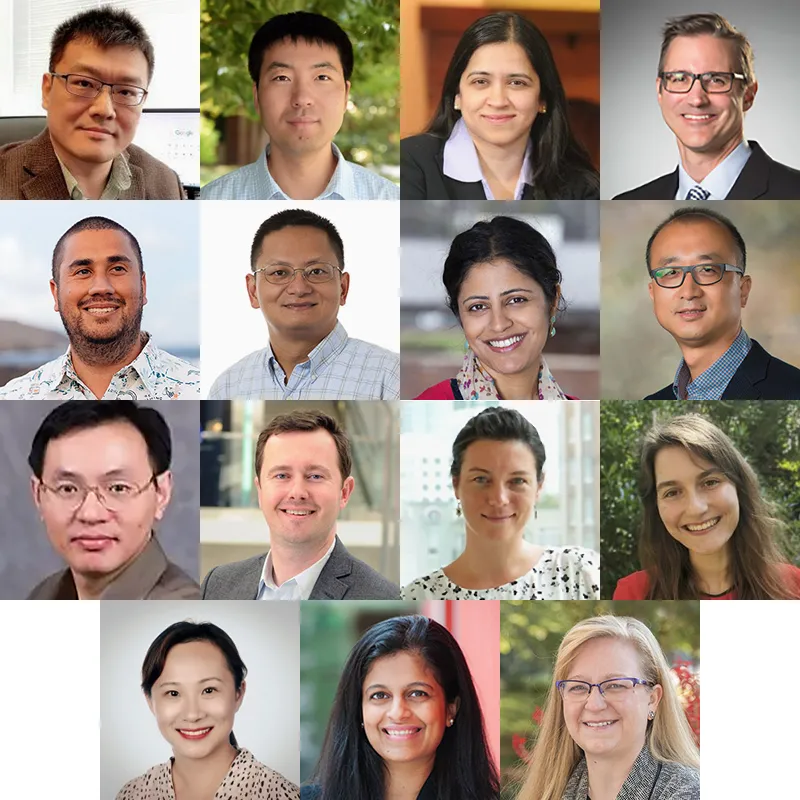Apr. 21, 2023
The Department of Energy has selected Georgia Institute of Technology as the Southeastern Regional Center of Excellence to enhance and expand the Industrial Assessment Centers (IACs) program. This new Center, in partnership with Clark Atlanta University, Kennesaw State University and Florida A&M University, will serve as a regional hub that collaborates and coordinates with government, nonprofit, labor, and industry actors to train clean energy workers and support small- and medium-sized manufacturers (SMMs) in their respective regions.
The Center involves two neighboring IACs comprised of the four universities and will serve as a regional and national enrichment resource for fellow IACs.
Specifically, the proposed Center of Excellence will: 1) leverage team expertise to advance the identification of technologies and approaches which increase energy efficiency, decarbonization, and productivity in cost-effective manner; 2) provide exemplars that facilitate networking and leveraging between IACs and complementary stakeholders (e.g., National Institute of Standards and Technology’s Manufacturing Extension Partnerships); and 3) equitably develop the clean energy workforce of the future – in part via the leadership role of the two HBCUs and the expansion of the Technologies for High Efficiency Realization via Minority Scholars (THERMS) program.
The proposed Center of Excellence is a natural leverage point and extension of the team’s present activities including:
Applied Energy Efficiency and Renewable Energy (EERE) research projects that directly map to highlighted technology interests within the Funding Opportunity Announcement (FOA), hence vivid subject matter expertise to aid identifying implementation opportunities;
Direct involvement of National Institute of Standards and Technology’s Manufacturing Extension Partnerships;
Delivery of credentialing energy management courses that are periodically enrolled by active workforce professionals, as well as faculty and students from other IACs.
Finally, the proposed Center of Excellence will also be a hub to receive and distribute insights from IACs within the region, and there will be keen attention upon distinctive needs within the Southeast (e.g., both clean and resilient energy enhancement given disruptive possibilities such as hurricanes). The two IACs’ location in metro-Atlanta and Georgia/North Florida allows the Center of Excellence to service underserved communities both in urban and rural locations.
Comas Haynes, research engineer at Georgia Tech Research Institute (GTRI) said, “This award is both an honor and excellent opportunity to expand Georgia Tech’s regional and national service of clean energy interventions and workforce development. Our partnership with Kennesaw State University, Clark Atlanta University, and Florida A&M University brings together University System of Georgia institutions, as well as leading HBCUs, and we look forward to supporting other IACs’ increased impact within the Southeast.”
News Contact
Priya Devarajan | SEI Communications Manager
Apr. 13, 2023
Electrical cables have been suspended over trams and trolley tracks for more than 140 years. They’ve electrified bullet trains in Japan and Amtrak railways that connect Washington D.C and Boston. Now the United States, Germany, and Sweden are testing the technology on highways, hoping to eliminate emissions from tractor-trailers.
A new study from Georgia Tech’s College of Engineering looks closer at using overhead cable line (OCL) technology to power trucks, evaluating if they are wise environmental and economical choices.
For some countries, including the United States as a whole, Sweden and Germany, the team suggests OCL technology is ideal. It’s also beneficial at the state level for New York, Washington, and Georgia. But for other areas, it shouldn’t be implemented until the region’s electric grid is cleaner.
Apr. 13, 2023
As climate change leads to rising sea levels and more powerful storms, coastal communities increasingly are turning to networks of sensors to track water levels. The sensors — which are progressively getting cheaper and more capable — can help officials anticipate flood risks and respond in emergencies.
A tool developed by Georgia Tech researchers can help make the most of those networks, pinpointing the ideal locations for water level sensors to maximize the real-time data available to emergency managers.
In a test case in Chatham County, Georgia, the approach developed by civil engineer Iris Tien reduced 29,000 potential sensor locations to just 381. The idea, then, is that officials can use their local expertise and historical knowledge to pick where to install sensors among those spots.
News Contact
Joshua Stewart
College of Engineering
Apr. 06, 2023
Professor Omer Inan is set to take the stage at the upcoming TEDxAtlanta 2023: We Rise event on May 19.
As the Linda J. and Mark C. Smith Chair in bioscience and bioengineering in Tech’s School of Electrical and Computer Engineering (ECE), Inan designs clinically relevant medical devices and systems and translates them from the lab to patient care applications. In his talk, Inan will be discussing his groundbreaking research on wearable healthcare technologies and the potential they hold for revolutionizing the field.
Inan is a member of the prestigious Medical and Biological Engineering (AIMBE) College of Fellows (elected in 2022) for his “outstanding contributions to the non-invasive assessment of the mechanical aspects of cardiovascular health and performance using wearable devices.” Additional achievements include an Academy Award for Technical Achievement from The Academy of Motion Picture Arts and Sciences (The Oscars, 2021), the Georgia Power Professor of Excellence for the College of Engineering (2019), and the National Science Foundation Faculty Early Career Development Program award (NSF CAREER, 2018).
TEDxAtlanta 2023: WE RISE brings together an impressive group of participants from diverse backgrounds, experiences, and perspectives. The speakers include entrepreneurs, activists, educators, artists, scientists, and many other changemakers who have risen above challenges to make a positive impact on the world.
The event's participants will share their stories and insights on how they have overcome adversity, embraced innovation, and challenged the status quo to make a difference in their communities and beyond. Through their talks, they will inspire and empower attendees to rise above their own challenges and take action towards creating a better future for all.
TEDxAtlanta 2023: WE RISE will take place on Friday, May 19 from 9 a.m. – 6:30 p.m. at the Rialto Center for the Arts (80 Forsyth Street Northwest Atlanta, GA 30303). Learn more and purchase tickets at tedxatlanta.com.
News Contact
Dan Watson
Apr. 04, 2023
Georgia Tech Battery Day opened with a full house on March 30, 2023, at the Global Learning Center in the heart of Midtown Atlanta. More than 230 energy researchers and industry participants convened to discuss and advance energy storage technologies via lightning talks, panel discussions, student poster sessions, and networking sessions throughout the day. Matt McDowell, associate professor in the Woodruff School of Mechanical Engineering and the School of Materials Science and Engineering as well as the initiative lead for energy storage at the Strategic Energy Institute and the Institute of Materials, started the day with an overview of the relevant research at Georgia Tech. His talk shed light on Georgia becoming the epicenter of the battery belt of the Southeast with recent key industry investments and the robust energy-storage research community present at Georgia Tech.
According to the Metro Atlanta Chamber of Commerce, since 2020, Georgia has had $21 billion invested or announced in EV-related projects with 26,700 jobs created. With investments in alternate energy technologies growing exponentially in the nation, McDowell revealed Georgia Tech is well-positioned to make an impact on the next generation energy storage technologies and extended an open invitation to industry members to partner with researchers. As one of the most research-intensive academic institutions in the nation, Georgia Tech has more than $1.3 billion in research and other sponsored funds and produces the highest number of engineering doctoral graduates in the nation.
“More than half of Georgia Tech's strategic initiatives are focused on improving the efficiency and sustainability of energy storage, supporting clean energy sources, and mitigating climate change," said Chaouki Abdallah, executive vice president for research at Georgia Tech. "As a leader in battery technologies research, we are bringing together engineers, scientists, and researchers in academia and industry to conduct innovative research to address humanity's most urgent and complex challenges, and to advance technology and improve the human condition."
Rich Simmons, director of research and studies at the Strategic Energy Institute moderated the first panel discussion that included industry panelists from Panasonic, Cox Automotive, Bluebird Corp., Delta Airlines and Hyundai Kia. The panelists analyzed the opportunities and challenges in the electric transportation sector and explained their current focus areas in energy storage. The panel affirmed that while EVs have been around for more than three decades, the industry is still in its infancy and there is a huge potential to advance technology in all areas of the EV sector.
The discussion also brought forth important factors like safety, lifecycle, and sustainability in driving innovations in the energy storage sector. The attendees also discussed supply chain issues, a hot topic in almost all sectors of the nation, and the need to develop a diversity of resources for more resilient systems. The industry panelists affirmed a strong interest in partnering on research and development projects as well as gaining access to university talent.
Gleb Yushin, professor in the School of Material Science and Engineering and co-founder of Sila Nanotechnologies Inc., presented his battery research and development success story at Georgia Tech. Sila is a Georgia Tech start-up founded in 2011 and has produced the world’s first commercially available high-silicon-content anode for lithium-ion batteries in 2021. Materials manufactured in its U.S. facilities will power electric vehicles starting with the Mercedes-Benz G-class series in 2023.
The program included lightning talks on cutting-edge research in battery materials, specifically solid-state electrolytes and plastic crystal embedded elastomer electrolytes (PCEEs) by Seung Woo Lee, associate professor in the George W. Woodruff School of Mechanical Engineering. Santiago Grijalva, professor in the School of Electrical and Computer Engineering, discussed the challenges and opportunities for the successful use of energy storage for the grid.
Tequila Harris, initiative lead for Energy and Manufacturing and professor in the George W. Woodruff School of Mechanical Engineering, spoke to energy materials and carbon-neutral applications. Presenting a case for roll-to-roll manufacturing of battery materials, Harris said that the need for quick, high yield manufacturing processes and alternative materials and structures were important considerations for the industry.
Materials, manufacturing, and market opportunities were the topic for the next panel moderated by McDowell and included panelists from Albemarle, Novelis, Solvay, Truist Securities, and Energy Impact Partners. Analyzing the current challenges, the panelists brought up hiring and workforce development, increasing capacity and building the ecosystem, decarbonizing existing processes, and understanding federal policies and regulations.
Lightning talks later in the afternoon by researchers at Georgia Tech touched on the latest developments in the cross-disciplinary research bridging mechanical engineering, chemical engineering, AI manufacturing, and material science in energy storage research. Topics included safe rechargeable batteries with water-based electrolytes (Nian Liu, assistant professor, School of Chemical & Biomolecular Engineering), AI-accelerated manufacturing (Aaron Stebner, associate professor, School of Materials Science and Engineering), battery recycling (Hailong Chen, associate professor, School of Materials Science and Engineering), and parametric life-cycle models for a solid-state battery circular economy (Ilan Stern, research scientist from GTRI).
Another industry panel on grid, infrastructure and communities moderated by Faisal Alamgir, professor in the School of Materials Science and Engineering included panelists from Southern Company, Stryten Energy, and the Metro Atlanta Chamber of Commerce. Improving the grid resiliency and storage capacity; proximity to the energy source; optimizing and implementing new technology in an equitable way; standardization of the evolving business models; economic development and resource building through skilled workforce; educating the consumer; and getting larger portions of the grid with renewable energy were top of mind with the panelists.
“Energy-storage-related R&D efforts at Georgia Tech are extensive and include next-gen battery chemistry development, battery characterization, recycling, and energy generation and distribution,” said McDowell. “There is a tremendous opportunity to leverage the broad expertise we bring to advance energy storage systems. Battery Day has been hugely successful in not only bringing this expertise to the forefront, but also in affirming the need for continued interaction with the companies engaged in this arena. Our mission is to serve as a centralized focal point for research interactions between companies in the battery/EV space and faculty members on campus.”
News Contact
Priya Devarajan || SEI Communications Manager
Mar. 21, 2023
Idling at a crossroads no longer, the automotive industry is embracing electrification like never before. With more electric vehicles purchased in 2022 than any year prior, consumers are beginning to follow their lead. Yet, while opportunity abounds, new challenges will require an innovative approach to ensure a sustainable and accessible electric future for all.
With historic investments from major players in the EV space, including Rivian, Kia, and Hyundai, the state of Georgia is uniquely positioned to serve as a leader in this effort. As the state's leading research institute, Georgia Tech is on the cutting edge of the movement.
The transportation sector is the largest greenhouse gas emitter in the U.S. at nearly 30%, with passenger vehicles accounting for around 80% of the sector's total output1 as of 2019. Electric vehicles are widely regarded as a budding solution to reduce emissions, but even as both demand and production continue to increase, EVs currently account for around 1% of the cars on America's roadways.
From the supply chain to the infrastructure needed to support alternative-fuel vehicles alongside consumer hesitancy, achieving the goals set by both the public and private sectors — including the Biden Administration's target of EVs making up at least 50% of new car sales by 2030 — will not be easy. Through research and development, policy, and collaboration, Tech experts are working toward finding solutions that will serve as catalysts during this transitionary period for the environment and the way Americans drive.
News Contact
Steven Gagliano - Communications Officer
Institute Communications
Mar. 03, 2023
The North American power grid is undergoing a generational transformation. Amid this change, an interdisciplinary research team of engineers and historians seeks to uncover the untold stories behind the algorithms and power systems architecture that have shaped the complex technological and social history of this key infrastructure.
“You can’t connect the dots looking forward; you can only connect them looking backwards.” These words, famously attributed to Steve Jobs, address the broad truth that only through intentional reflection and examination can we learn from the past.
With this in mind, an interdisciplinary research team comprised of engineers and historians from the Georgia Institute of Technology, the University of Houston, and the University of Minnesota are hoping to shape the future of electric power grids by studying and cataloguing the field’s robust history during a two-year study funded by the Alfred P. Sloan Foundation
“While electrical engineering is at the forefront of many of today’s technological advancements, a critical step in the process of innovative and cutting-edge research is working to understand the past,” said Dan Molzahn, assistant professor in the Georgia Tech School of Electrical and Computer Engineering and the project’s principal investigator.
The group’s project, "Algorithms and Power Systems Architecture: Using Historical Analysis to Envision a Sustainable Future", emerges out of the Sloan Foundation’s emphasis to award historical scholarship projects that look to understand the contemporary context of scientific research and inform current and future research and policy practices. The study will examine the relatively invisible, yet central, role of the algorithms 20th-century engineers developed to provide optimization and control of the electric power grid and the ways in which these algorithms might impact the cleaner grid of the future.
“Clarifying how invisible technologies [like algorithms] became established in large and complex power systems is the ultimate goal of the project,” said Molzahn. “As algorithms became thoroughly naturalized within power systems architecture, they set the boundaries and established the scope of possibility; this can restrict innovation across the technology spectrum.”
The research team — two historians and two engineers — represents an innovative alliance of technical, historical, and public policy approaches. In addition to Molzahn, the team includes Sairaj Dhople, associate professor of electrical and computer engineering at the University of Minnesota (UMN); Julie Cohn, a research historian at the Center for Public History at the University of Houston (UH); and Monica Perales, associate professor of history and director of the Center for Public History at UH.
The project comes at a time when power grids are in the throes of new demands and transformation. As a result of aging technology and regulatory structures that impede upgrades of essential power infrastructure, current grids are inadequate in integrating renewable energy sources at the scale the market requires. Energy providers and researchers are also looking for ways to guard power systems against cyber assaults, as well as against an increased risk of extreme weather events due to climate change — the average overall duration of power interruptions due to weather in the U.S. doubled since 2015, according to the U.S. Department of Energy.
“The opportunities and challenges of widespread electrification are front and center for the public. Debates about climate change, opposition to large-scale energy infrastructure, and periodic weather-related power outages appear in the news regularly,” said Cohn, who is an expert on the development of the North American electric power grid and author of the book “The Grid” on the topic.
A particularly important part of the project is collecting the oral history of individuals who were instrumental in the development, adoption, and application of algorithms in North America. The team will train history and engineering graduate students to conduct approximately 50 interviews with members of the National Academy of Engineering, IEEE Fellows, and prominent power systems engineers.
“The interviews themselves will be the best way to make this project relevant for a non-technical audience,” said Perales, an expert on oral history methods. “When you hear a person tell their story about why they became interested in working on the power system, it is often more than a ‘technical’ story. They offer insight into the ‘why’, which is always compelling.”
The interviews will be archived at UH and the IEEE History Center, and will eventually be made available to other researchers and the public. The team will use the interviews as important source information to produce a podcast that interprets the highly technical history of algorithms and power systems architecture for a broad audience, especially those interested in climate change and sustainability.
The completed history will then be leveraged in engineering courses taught by Molzahn at Tech and Dhople at the UM with the hope that other institutions will utilize the team’s findings to provide appropriate historical context in their power engineering courses.
News Contact
Dan Watson
dwatson@ece.gatech.edu
Feb. 23, 2023
The North American power grid is undergoing a generational transformation. Amid this change, an interdisciplinary research team of engineers and historians seeks to uncover the untold stories behind the algorithms and power systems architecture that have shaped the complex technological and social history of this key infrastructure.
“You can’t connect the dots looking forward; you can only connect them looking backwards.” These words, famously attributed to Steve Jobs, address the broad truth that only through intentional reflection and examination can we learn from the past.
With this in mind, an interdisciplinary research team comprised of engineers and historians from the Georgia Institute of Technology, the University of Houston, and the University of Minnesota are hoping to shape the future of electric power grids by studying and cataloguing the field’s robust history during a two-year study funded by the Alfred P. Sloan Foundation.
“While electrical engineering is at the forefront of many of today’s technological advancements, a critical step in the process of innovative and cutting-edge research is working to understand the past,” said Dan Molzahn, assistant professor in the Georgia Tech School of Electrical and Computer Engineering and the project’s principal investigator.
The group’s project, "Algorithms and Power Systems Architecture: Using Historical Analysis to Envision a Sustainable Future", emerges out of the Sloan Foundation’s emphasis to award historical scholarship projects that look to understand the contemporary context of scientific research and inform current and future research and policy practices. The study will examine the relatively invisible, yet central, role of the algorithms 20th-century engineers developed to provide optimization and control of the electric power grid and the ways in which these algorithms might impact the cleaner grid of the future.
“Clarifying how invisible technologies [like algorithms] became established in large and complex power systems is the ultimate goal of the project,” said Molzahn. “As algorithms became thoroughly naturalized within power systems architecture, they set the boundaries and established the scope of possibility; this can restrict innovation across the technology spectrum.”
The research team — two historians and two engineers — represents an innovative alliance of technical, historical, and public policy approaches. In addition to Molzahn, the team includes Sairaj Dhople, associate professor of electrical and computer engineering at the University of Minnesota (UMN); Julie Cohn, a research historian at the Center for Public History at the University of Houston (UH); and Monica Perales, associate professor of history and director of the Center for Public History at UH.
The project comes at a time when power grids are in the throes of new demands and transformation. As a result of aging technology and regulatory structures that impede upgrades of essential power infrastructure, current grids are inadequate in integrating renewable energy sources at the scale the market requires. Energy providers and researchers are also looking for ways to guard power systems against cyber assaults, as well as against an increased risk of extreme weather events due to climate change — the average overall duration of power interruptions due to weather in the U.S. doubled since 2015, according to the U.S. Department of Energy.
“The opportunities and challenges of widespread electrification are front and center for the public. Debates about climate change, opposition to large-scale energy infrastructure, and periodic weather-related power outages appear in the news regularly,” said Cohn, who is an expert on the development of the North American electric power grid and author of the book “The Grid” on the topic.
A particularly important part of the project is collecting the oral history of individuals who were instrumental in the development, adoption, and application of algorithms in North America. The team will train history and engineering graduate students to conduct approximately 50 interviews with members of the National Academy of Engineering, IEEE Fellows, and prominent power systems engineers.
“The interviews themselves will be the best way to make this project relevant for a non-technical audience,” said Perales, an expert on oral history methods. “When you hear a person tell their story about why they became interested in working on the power system, it is often more than a ‘technical’ story. They offer insight into the ‘why’, which is always compelling.”
The interviews will be archived at UH and the IEEE History Center, and will eventually be made available to other researchers and the public. The team will use the interviews as important source information to produce a podcast that interprets the highly technical history of algorithms and power systems architecture for a broad audience, especially those interested in climate change and sustainability.
The completed history will then be leveraged in engineering courses taught by Molzahn at Tech and Dhople at the UM with the hope that other institutions will utilize the team’s findings to provide appropriate historical context in their power engineering courses.
__
LISTEN NOW!
Discovering Power in the Past: The Algorithms and Power Systems Architecture Project from the University of Houston's "Public Historians at Work" podcast.
News Contact
Dan Watson
dwatson@ece.gatech.edu
Feb. 09, 2023
Ten projects have been chosen for the Brook Byers Institute for Sustainable Systems (BBISS) Initiative Leads program. Project themes include climate adaptation and mitigation solutions, innovation and social impact, computation and design approaches to sustainability, sustainable development, and conservation. BBISS Initiative Leads receive $10,000 in discretionary funds to advance their project.
The projects chosen involve 15 faculty members hailing from all 6 of the colleges at Georgia Tech. Several of the projects are also joint initiatives with other Georgia Tech Interdisciplinary Research Institutes (IDEAS, IPAT, and SEI), the Ray C. Anderson Center for Sustainable Business, or the Office of Sustainability.
The Initiative Leads and projects are:
- Michael Helms - ME, “Nature’s Voice: Amplifying the Narrative of Biologically Inspired Sustainable Design at Georgia Tech”
- Josiah Hester - Interactive Computing, “Computational Sustainability”
- Co-Leads Xiaoming Huo - ISYE, and Yi Deng – EAS, “Microclimate Monitoring and Prediction at Georgia Tech”
- Jian Luo - CEE, “Coastal Urban Flooding in a Changing Climate”
- Brigitte Stepanov - Modern Languages, “Energy Today, Tomorrow: Illuminating the Effect of Energy Power Dynamics on the Environment”
- Co-Leads Anjali Thomas – INTA, and Shatakshee Dhongde - ECON, “SEEDS (Southeast Exchange of Development Studies) 2023 Conference at Georgia Tech”
- Co-Leads Danielle Willkens - Arch, and Junshan Liu – Auburn University, “Sustainable Tourism, Petra”
- Co-Leads Yuanzhi Tang - EAS, and Hailong Chen – ME, “Sustainable Resources for Clean Energy”
- Co-Leads Dori Pap - Institute for Leadership and Social Impact, and Neha Kumar – Interactive Computing/INTA, “Collaborative Social Impact”
- Alex Oettl - COB, “A Sustainability-Focused Stream of the Creative Destruction Lab”
The Initiative Leads program has several overarching goals. BBISS aims to cultivate promising topics for future large-scale collaborative sustainability research, research translation, and/or high-impact outreach; to provide (mostly mid-career) faculty with leadership and community building opportunities; and to broaden and strengthen the BBISS sustainability community as a whole.
News Contact
Brent Verrill, Research Communications Program Manager, BBISS
Feb. 06, 2023
Researchers at the Georgia Tech Research Institute (GTRI) are using additive manufacturing techniques to create unique waveguide structures that would be difficult or impossible to make using conventional fabrication processes. The new techniques are especially useful for integrating updated components into equipment that might otherwise require significant design changes.
In high-powered millimeter wave and microwave radars and antennas, waveguides direct electromagnetic energy from one component to another inside the equipment. Until recently, the waveguides had been fabricated from extruded copper or aluminum tubing, but these traditional manufacturing techniques can’t always accommodate the complex configurations needed for optimal design with minimal energy transmission losses.
“To propagate electromagnetic waves efficiently, the waveguide must have a very precise internal geometry,” explained GTRI Senior Research Engineer Kyle Azevedo. “Yet, the waveguide must also be very smooth in terms of its internal surface finish. The cavity that transmits the energy has to be very well controlled to avoid significant losses. And the waveguides must also fit into confined spaces.”
Additive Techniques Offer Specific RF Advantages
To allow more complex designs, GTRI researchers are evaluating two alternative fabrication techniques: 3D-printed structures fabricated from metal and 3D-printed polymer components that are metal coated. Each has advantages and disadvantages and must be chosen for the specific application. The researchers are testing waveguides made using both techniques for mechanical performance in resisting fatigue damage, thermal performance in dissipating heat, electrical performance – and their RF energy loss.
Flexibility afforded by additive techniques can help designers accommodate waveguides within a crowded design that includes many other components. In one current project, the researchers found that they needed to move a radar’s feed horn several inches to accommodate other design considerations. But that complicated the waveguide design.
“That was a really big challenge, because we had to change some of the existing waveguides, and we couldn’t do that with traditional tubing pieces that were available without coming up with a whole new design,” Azevedo said. “But by using additive processes that allow more customization, we were able to make things smaller and optimize the design in a single iteration.”
In another project – in consideration for use on Army counter-battery radar – researchers at U.S. Army DEVCOM C5ISR Center used additive techniques to accommodate an updated component of a different size and shape than the original to improve RF performance. The researchers designed a 3D-printed waveguide that accommodated the existing connectors and integrated into its legacy systems, then worked with the Army’s Rock Island Arsenal to optimize fabrication and quality control. That new component was successfully tested at Tobyhanna Army Depot and Yuma Proving Ground, and is now being evaluated as an OEM alternative. This may allow additive manufacturing to augment the supply system.
In addition to facilitating designs that might otherwise have been more challenging, the GTRI researchers expect additive manufacturing will allow them to accelerate the iterative development of prototypes by moving some waveguide fabrication in-house.
Overcoming Challenges with New Fabrication Methods
For all-metal waveguides, additive manufacturing can have some disadvantages, but those may not be as significant as they might first appear. To limit transmission losses, inside surfaces of conventional waveguides are smooth, but because of the way metal 3D printing works, smooth internal surfaces can be difficult to fabricate. The design flexibility of additive processes can make up for that.
“In one of our designs, we found that even though we might have some limitations on the roughness of the surface finish, we could gain back the transmission losses by optimizing the waveguide shape,” Azevedo explained. “The final design would not have been possible using traditional waveguide fabrication techniques.”
Though applying metal coatings to waveguides produced from polymers or resins can provide smoother surfaces, this process comes with its own set of challenges.
“One of the issues we are tackling now is that a lot of the resins and polymers that have desirable properties for plating contain silica,” said Max Tannenbaum, a GTRI research engineer. “They are ceramic-like when cured, but when you remove the resin, a lot of the conventional solvents don’t remove the silica, and you end up with a chalky powder on the surface. If you can’t remove that before you try to plate it, the plating won’t adhere.”
Building a Knowledge Base for RF Applications of Additive Processes
To support expanded applications for waveguides fabricated using additive techniques, the researchers are using both simulation and experimentation to develop comprehensive design information.
“The traditional method for making waveguides has been around since World War II, when the original systems got up and running, and those techniques have been refined over the decades since then,” said Azevedo. “As a result, there’s a wealth of detailed data on what works, including the metallurgic properties. We want to develop a comparable depth of understanding for the new additive manufacturing techniques that offer so many advantages.” By putting together what they have learned, the research team plans to share their knowledge with other RF engineers who may be interested in the additive approaches.
“Our effort is focusing on two parallel paths: looking at the mechanical constraints involved with fabrication and the RF limitations,” said GTRI Research Engineer Austin Forgey. “We are merging the new experimental data we’re getting with RF simulations, and combining that with testing mechanical properties. That will give us a full design package that can be used by the designers who need it.”
Beyond waveguides, the GTRI researchers are working on other applications of additive manufacturing to RF design. With researchers in Georgia Tech’s School of Mechanical Engineering, they are fabricating cold plates that are 3D printed from aluminum and used to cool high-powered electronics. The 3D printing allows novel fluid flow in a single part, not possible with conventional fabrication.
Similarly, they are also looking at additive techniques to make shielding needed to protect components from electromagnetic interference.
While they expect to expand their use of additive fabrication approaches to provide new design options for RF applications, the researchers don’t see additive manufacturing doing away with conventional fabrication techniques any time soon.
“My opinion is that there will certainly be a mix because additive manufacturing techniques aren’t the answer for everything,” said Tannenbaum. “But they are solutions to a lot of specific problems that we encounter, allowing us to build parts that are cheaper, lighter, and available more quickly.”
Writer: John Toon
GTRI Communications
Georgia Tech Research Institute
Atlanta, Georgia USA
About GTRI: The Georgia Tech Research Institute (GTRI) is the nonprofit, applied research division of the Georgia Institute of Technology (Georgia Tech). Founded in 1934 as the Engineering Experiment Station, GTRI has grown to more than 2,800 employees, supporting eight laboratories in over 20 locations around the country and performing more than $700 million of problem-solving research annually for government and industry. GTRI's renowned researchers combine science, engineering, economics, policy, and technical expertise to solve complex problems for the U.S. federal government, the state, and industry. For more information, please visit www.gtri.gatech.edu.
News Contact
(Interim) Director of Communications
Michelle Gowdy
Michelle.Gowdy@gtri.gatech.edu
404-407-8060
Pagination
- Previous page
- 16 Page 16
- Next page
